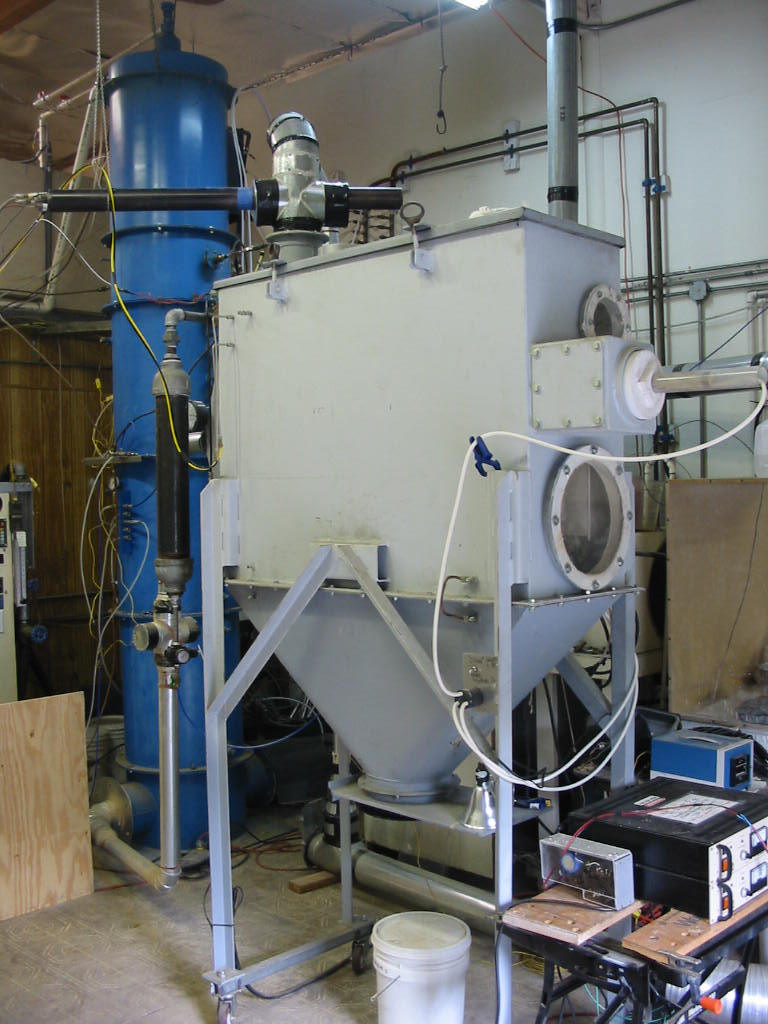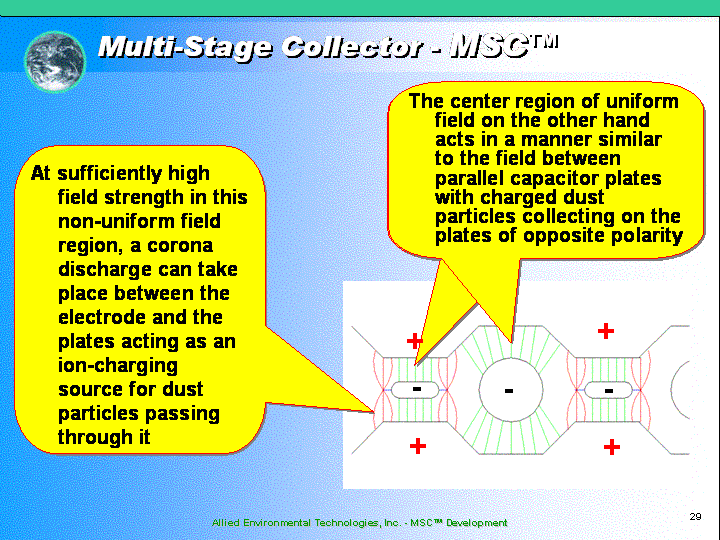

 |
 |
![]() llied
Environmental Technologies, Inc. has a dedicated research and development group
working within its key areas of expertise. R&D efforts aimed at finding
practical solutions to air pollution, mass and heat transfer, fluid dynamics,
processes in single and multi-phase fluid flows, and applied energy systems.
Available control methods are evaluated and applied were appropriate. When
necessary, new technologies are developed through in-depth analysis, followed by
bench and pilot scale experimentation.
llied
Environmental Technologies, Inc. has a dedicated research and development group
working within its key areas of expertise. R&D efforts aimed at finding
practical solutions to air pollution, mass and heat transfer, fluid dynamics,
processes in single and multi-phase fluid flows, and applied energy systems.
Available control methods are evaluated and applied were appropriate. When
necessary, new technologies are developed through in-depth analysis, followed by
bench and pilot scale experimentation.
![]() LLIED develops and
commercializes innovative new ideas using our in-house specialists and bringing together consultants,
engineers, and scientists from key partners throughout the world.
LLIED develops and
commercializes innovative new ideas using our in-house specialists and bringing together consultants,
engineers, and scientists from key partners throughout the world.
![]() llied Environmental
Technologies, Inc. developed and perfected numerous computer models to assist in the
Electrostatic Precipitators performance evaluation, fly ash resistivity and available
methods of its modification modeling. The company's array of expertise also includes
Computations Fluid Dynamics (CFD) modeling to analyze flue gas mixing, chemical reaction
kinetics, mass and heat transfer. This tool permits more accurate prediction of system
performance and improves equipment design.
llied Environmental
Technologies, Inc. developed and perfected numerous computer models to assist in the
Electrostatic Precipitators performance evaluation, fly ash resistivity and available
methods of its modification modeling. The company's array of expertise also includes
Computations Fluid Dynamics (CFD) modeling to analyze flue gas mixing, chemical reaction
kinetics, mass and heat transfer. This tool permits more accurate prediction of system
performance and improves equipment design.
![]() ombining our
expertise and knowledge of air emissions control technology, Allied Environmental
Technologies, Inc. brings state-of-the-art control techniques and proprietary technologies
to help successfully solve client's problems.
ombining our
expertise and knowledge of air emissions control technology, Allied Environmental
Technologies, Inc. brings state-of-the-art control techniques and proprietary technologies
to help successfully solve client's problems.
![]() pecifically,
we offer expertise of many years working with particulate equipment design,
performance analyses, and its improvement. Our expertise is based on years
working with particulate equipment design, performance analyses, and its
improvement. Selected examples of the projects handled in the past are listed
below:
pecifically,
we offer expertise of many years working with particulate equipment design,
performance analyses, and its improvement. Our expertise is based on years
working with particulate equipment design, performance analyses, and its
improvement. Selected examples of the projects handled in the past are listed
below:
Particulate control devices specification, selection, design and performance evaluation
Particulate control devices evaluation in conjunction with FGD systems design and operation
ESP/Fabric Filter - Dry FGD system pilot for 500 MW boiler unit design and operation
ESP computer modeling, performance evaluation and guarantees development and evaluation
Computer modeling of fly ash resistivity and its modification
Development of novel processes and methods for flue gas conditioning (FGC)
Development of innovative ways to automatically control FGC processes
Design and operation of the full-scale demonstration system for a fabric filter with dual (SO3 and NH3) flue gas conditioning system evaluation.
Design, manufacturing, installation supervision, start-up, and shakedown of the full-scale SNCR systems on urea.
Design, manufacturing, installation supervision, start-up, and shakedown of the fully automated mini-plant to manufacture the urea solution.
Electrostatic Precipitator Design (US Patent No. 5,547,493)
Multi-Stage Collector (MSCtm)
(US Patents 6,524,369 and 6,932,857)
![]() t is well known in the art how
to build and use electrostatic precipitators. It is also known in the art how
to build and use a barrier filter such as a baghouse. Further, it is known in
the art how to charge particles and that charged particles may be collected in a
barrier filter with lower pressure drop and emissions than uncharged particles
collected for the same filtration velocity.
t is well known in the art how
to build and use electrostatic precipitators. It is also known in the art how
to build and use a barrier filter such as a baghouse. Further, it is known in
the art how to charge particles and that charged particles may be collected in a
barrier filter with lower pressure drop and emissions than uncharged particles
collected for the same filtration velocity.
![]() he invention consists of a new method
and design for a novel multi-stage collector for collecting dust, fume, etc.
for industrial gases, that is, basically, independent of electrical
resistivity, thus it is especially beneficial when electrical resistivity of
such dust or fume as precipitated, exceeds 1011 Ohm-cm or is
extremely low, for example less than 104 Ohm-cm. Furthermore, this
design will be particularly advantageous when the material to be collected
consists mostly of a sub-micron dust and/or fume (PM 2.5). It also could be
easily integrated with various catalysts for multitude of the gaseous
pollutants collection.
he invention consists of a new method
and design for a novel multi-stage collector for collecting dust, fume, etc.
for industrial gases, that is, basically, independent of electrical
resistivity, thus it is especially beneficial when electrical resistivity of
such dust or fume as precipitated, exceeds 1011 Ohm-cm or is
extremely low, for example less than 104 Ohm-cm. Furthermore, this
design will be particularly advantageous when the material to be collected
consists mostly of a sub-micron dust and/or fume (PM 2.5). It also could be
easily integrated with various catalysts for multitude of the gaseous
pollutants collection.

![]() he
novel Multi-Stage Collector (MSCTM) design is motivated by a potential ability of the
two-stage to collect and agglomerate small particulate matter and of the
single-stage to collect and retain "blowoff" dust, which is lost from the
"conventional" two-stage design. Furthermore, it also incorporates an
additional collector stage by screening the gas exiting the collector through
the barrier collector zone. This arrangement assures that essentially all dust
(either uncollected in electrostatic collection zones or being re-entrained in
the gas stream during the rapping and/or bag-cleaning steps) would be detained
in this final stage.
he
novel Multi-Stage Collector (MSCTM) design is motivated by a potential ability of the
two-stage to collect and agglomerate small particulate matter and of the
single-stage to collect and retain "blowoff" dust, which is lost from the
"conventional" two-stage design. Furthermore, it also incorporates an
additional collector stage by screening the gas exiting the collector through
the barrier collector zone. This arrangement assures that essentially all dust
(either uncollected in electrostatic collection zones or being re-entrained in
the gas stream during the rapping and/or bag-cleaning steps) would be detained
in this final stage.
![]() he
MSCTM design is free of the detrimental characteristic of the
single-, and two-stage electrostatic precipitators, as well as known
electrostatically enhanced barrier filters design:
he
MSCTM design is free of the detrimental characteristic of the
single-, and two-stage electrostatic precipitators, as well as known
electrostatically enhanced barrier filters design:
it continuously offers ample supply of the ions for aerosol particles charging,
by a virtue of the unique design offers improved collection efficiency, and
it also incorporates an additional collector stage by screening the gas exiting the collector through the barrier collector zone
![]() t also offers very high
collection efficiency in a submicron region. It is mostly advantageous in the
high resistivity applications. The compactness and ease of manufacturing is yet
another important factor of this design.
t also offers very high
collection efficiency in a submicron region. It is mostly advantageous in the
high resistivity applications. The compactness and ease of manufacturing is yet
another important factor of this design.
![]() pecifically,
the MSCTM could find its use within the following areas/applications:
pecifically,
the MSCTM could find its use within the following areas/applications:
1. Super clean exhaust gases: “Vision 21”
2. Integrated Gasification Combined Cycle (IGCC): super-clean de-dusting process (synthetic) gases from the gasification equipment prior to the introduction into the combustion turbine
3. Industrial mineral processing industries:
a. In-process capture of the expensive product material and return to the process, i.e. metals, rock-dust, gold, etc.
b. Post-processing super-clean de-dusting prior to exhaust to the atmosphere.
4. Multi-pollutant applications, i.e. SOx, NOx, Hg, etc. via integrating (or impregnating) catalyst materials within the barrier filter.
5. The MSC design is superbly compact and warrants very high efficiencies in the sib-micron/ultra-fine particulate range. Hence, it may be also suitable for the gas turbine inlet air cleaning.
![]() inally, by integrating one of
the stages (barrier) with one or several catalytical materials, this novel
(MSCTM) may become an “ultimate” emissions control apparatus.
inally, by integrating one of
the stages (barrier) with one or several catalytical materials, this novel
(MSCTM) may become an “ultimate” emissions control apparatus.
PROOF-OF-CONCEPT PILOT PERFORMANCE TESTS
Below is a graph depicting the Proof-of-Concept pilot unit results in the "conventional" Pulse-JET (ESP power OFF) vs. MSCTM mode (ESP power ON). Clearly, MSCTM mode offers significantly higher efficiency, hence, lower emissions and better pressure drop characteristics.
The Engineering ToolBox - The Engineering ToolBox